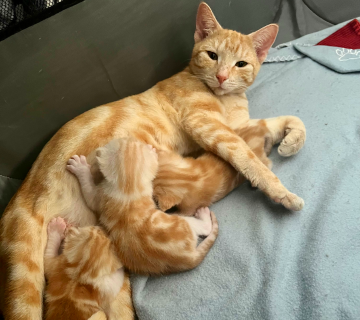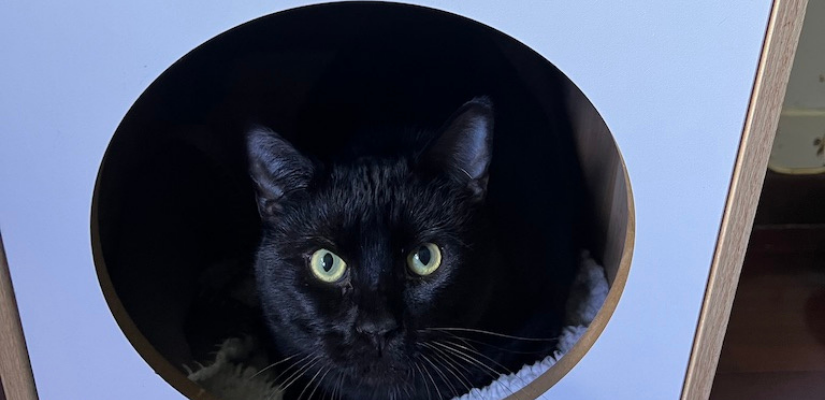Losing a beloved feline companion can be a distressing experience for any cat owner. There are important steps to take to give your cat the best chance of coming back home, and by reading this blog post you can put together an action plan for how to prevent losing your cat, and what to do if they disappear.
We’ll explore strategies and steps to take when your cat goes missing. We’ll discuss where to start looking, what to do when it’s been more than 24 hours, the survival skills cats employ when outside, and tips for increasing the chances of your furry friend returning home safely.
My Cat Has Gone Missing – What Do I Do?
Where to Start Looking for Your Missing Cat
Before you start to panic, it’s important to do a thorough check of your home and garden to look for your cat. Many owners become upset quickly when they think their cat has gone missing, just to find them curled up in a dark corner. The first step should always be to go through your home with a fine-tooth-comb, double and triple checking that your cat isn’t just hiding.
Once you’re certain your cat is not on your property and could be in danger, it’s time to get serious and start the steps to get them safe and home. Remain calm – the last thing you and your cat need is for you to be stressed and upset, since this will affect your ability to strategically search.
Go through each of these steps:
- Search the Immediate Area: Begin your search close to home, as cats often hide nearby when they feel threatened or scared. Look in your yard, garden, and any hideaways in your immediate vicinity. Cats don’t often wander far out of their territory – even outdoor cats, but especially not indoor ones – so it’s most likely they’re close.
- Look Up: Don’t forget to scan trees and other climbable objects in your area, as cats are known to seek high spots to feel safe, but are notorious for getting themselves stuck.
- Ask Your Neighbours: Cats sometimes wander into neighbours’ properties and may get accidentally trapped. Inform your neighbours and ask them to check their garages, sheds, and under their decks. Just like they can hide well in your house, cats can hide extremely well outside, and if they’re scared, they may stay hidden (such as within a bush or under a car) even when they see you looking and calling for them.
- Look for Neighbourhood Cats: If your cat isn’t spayed or neutered, they may have gone in search of a mate. If you know of other cats in your area, go to the places they frequent and see if your cat has gone to join them.
- Check Your Previous Home: If you’ve recently moved, and aren’t unrealistically far away from your old house, your cat may have gone searching for it to go ‘home’.
- Leave Your Door Open: If it’s safe to do so, leave open the door they’re most familiar with/most likely exited through. This means that they can wander back in on their own accord and in their own time, which could be especially important if fear drove them away.
What to Do When It’s Been More Than 24 Hours
As time passes, the anxiety about your missing cat may intensify. At this point, they may have wandered further away, gotten into trouble, and might be getting hungry. Here are the next steps to take:
- Contact Local Animal Shelters: Reach out to local shelters, veterinarians and animal control agencies to check if your cat has been picked up. Provide them with a detailed description of your cat and its identifying features.
- Expand the Search Radius: Increase your search area and broaden your outreach to other neighbourhoods.
- Report to Microchip and Pet Registries: If your cat is microchipped, report them as missing to the microchip registry and pet identification services. If your contact information is up-to-date, this can facilitate your cat’s return if found.
- Create a ‘Lost Cat’ Poster: Design a poster with your cat’s photo and contact information and distribute it in your neighbourhood. You can easily put together a poster simply using a Word document or PowerPoint slide, adding an image and some text. Make sure to include your contact details and information about any distinguishing features your cat may have.
- Online and Social Media: Utilise social media platforms and websites dedicated to lost and found pets to spread the word about your missing cat. Share the post on your social profiles and in local community groups.
- Maintain Communication: Continue to share information about your missing cat with your local community. Don’t underestimate the power of community support in finding lost pets. Consider focusing on people who are in your local streets often, like delivery drivers, dog walkers, runners, etc. who tend to be there every day and could keep an eye out for a missing pet.
- Search During Peak Activity Times: Early morning and evening are when cats are more likely to move around. Use a torch to search for your cat during nighttime hours. Cats often feel safer when it’s quieter and less crowded.
How Cats Survive Outside
Cats possess remarkable survival skills when outdoors. Though some are more adept than others, many cats have great hunting and hiding skills. They may sneak into other cat yards and homes and steal food.
Cats may hunt for birds, rodents, or insects to sustain themselves. This is a natural survival instinct, and even well-fed cats may engage in hunting when outdoors. They also look for water sources like puddles or open containers. Staying hydrated is crucial for their survival.
They find hiding spots and avoid confrontations with other animals. They’ll often hide in bushes, under decks, or in any available nook. They might hide in dense vegetation during the day and become more active at dawn and dusk. Cats are crepuscular, meaning they are most active during these times, which can improve their chances of finding food.
What you can do to help your cat is to leave some supplies outside, like food, water, and a bed/shelter. This is in case they wander home when you aren’t there, or visit during the night needing help.
Indoor Cats vs. Outdoor Cats Survival Skills
Indoor cats may lack the hunting and survival skills of their outdoor counterparts. Indoor cats are often sheltered from the harsh realities of the outside world, which can make them vulnerable if they become lost. They also won’t be used to having much outdoor space, and could become confused quickly. Indoor cats are at higher risk when they go missing, so it’s especially important to be vigilant in finding them.
Cats with outdoor experience may have better hunting and survival skills. Outdoor cats may adapt better to the challenges of a new outdoor environment. However, this doesn’t eliminate the risks they face.
Why Your Cat Might Have Gone Missing
There are various reasons why your cat may have gone missing. Understanding these factors can provide insights into your cat’s behaviour and how to prevent future disappearances:
- Loud Noises: Sudden loud noises like thunderstorms, fireworks, or construction work can startle a cat, causing them to bolt and become disoriented.
- Change in Environment: Moving to a new home, renovations, or significant changes in their living environment can confuse a cat. They might venture out in search of their old territory.
- Introduction of a New Pet: The addition of a new pet, especially if there are tensions or territorial disputes, may prompt a cat to explore or escape.
- Curiosity: Cats are naturally curious animals. They may wander far from home simply because something piqued their interest. Their curious nature can lead them into new and unfamiliar territories, making it challenging to find their way back.
- Sickness: Cats may leave if they think it’s close to the end of their life
How to Prevent Your Cat From Going Missing
Prevention is the key to ensuring your cat doesn’t go missing in the first place. Here are some essential steps to safeguard your feline friend:
- Microchipping: Get your cat microchipped and ensure your contact information is up-to-date. Microchips significantly increase the chances of a lost cat being reunited with its owner.
- Keep a Photo of Your Pet: Always have recent photographs of your pet that can be used to help identify them. Also make note of any unique markings they might have. Anything that could help to identify them when missing can increase your chances of finding them promptly.
- Secure Windows and Doors: Ensure that windows and doors are secure, preventing your cat from slipping out accidentally.
- Supervise Outdoor Time: If you allow your cat outdoors, supervise their time outside or consider using a secure outdoor enclosure.
- Regular Vet Check-Ups: Maintain regular vet check-ups to address any health or behaviour concerns that may contribute to your cat’s desire to roam.
- Provide Mental Stimulation: Enrich your cat’s indoor environment with toys, scratching posts, and interactive play. A stimulated and happy cat is less likely to feel the need to explore beyond your home.
When it’s been a few weeks
Even after quite some time, don’t give up hope. You never know where your cat might have ended up, and if they’re happily surviving on their own until they’re ready to return home. There are many miracle stories of lost cats showing up months or even years later. These mysterious creatures often surprise us.
Continue checking with shelters and vets, keep your neighbours notified that they’re still missing, and continue to leave out food and familiar-smelling items to help them find home.
The experience of a missing cat can be incredibly distressing, but understanding how to react and what steps to take can improve the chances of a happy reunion. By following the suggested steps in this blog post, you can increase the likelihood of finding your missing cat or, even better, prevent them from disappearing in the first place.

Are you looking to adopt a pet or donate to a pet rescue organisation? Georgie and Cindy from Large Hope SEO foster cats and kittens on the Sunshine Coast in Australia. If you’re local, get in touch to discuss adopting from the rescues. See cats and kittens available for adoption or donate so we can save more kittens.
 seolounge
seolounge